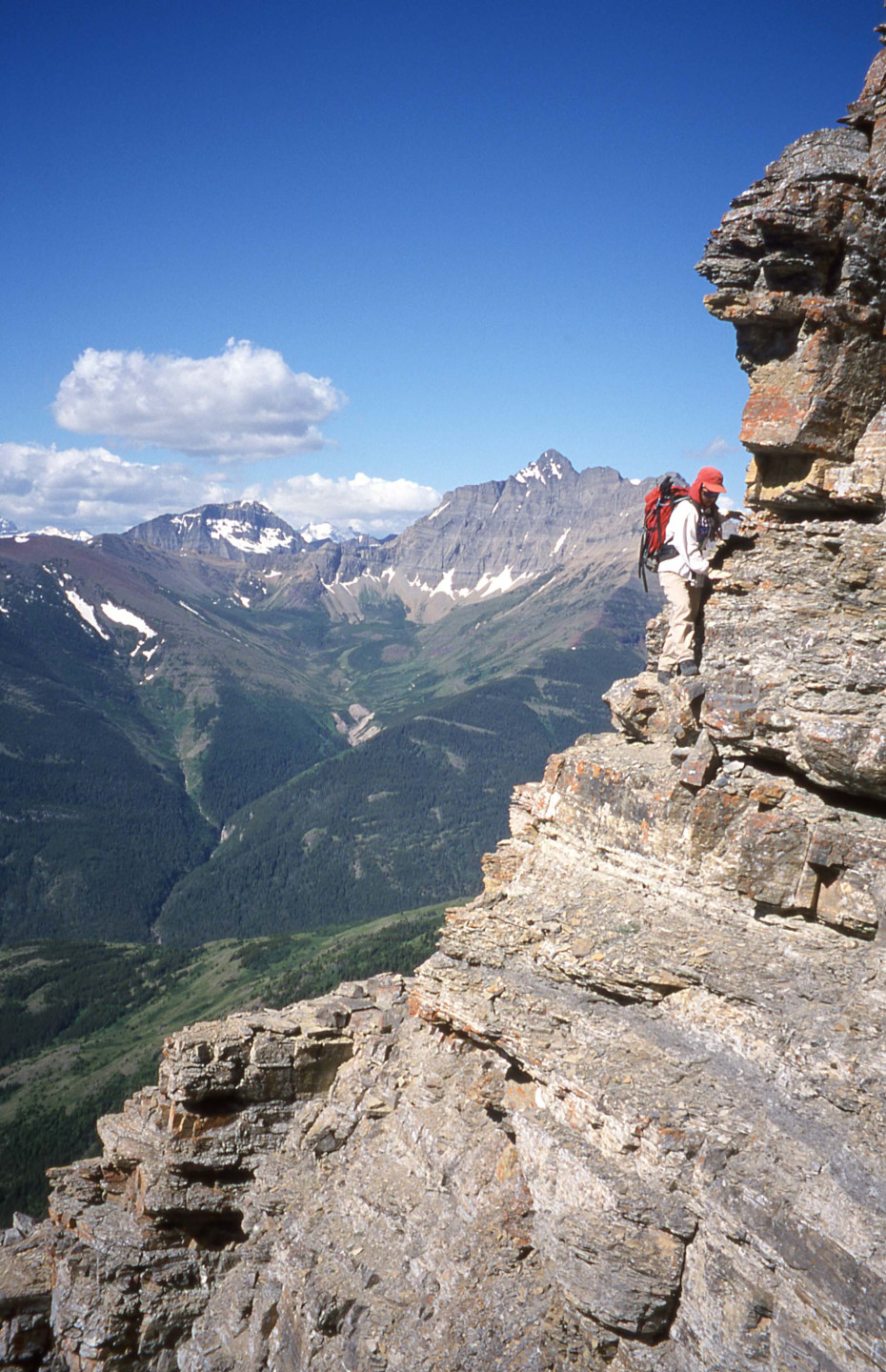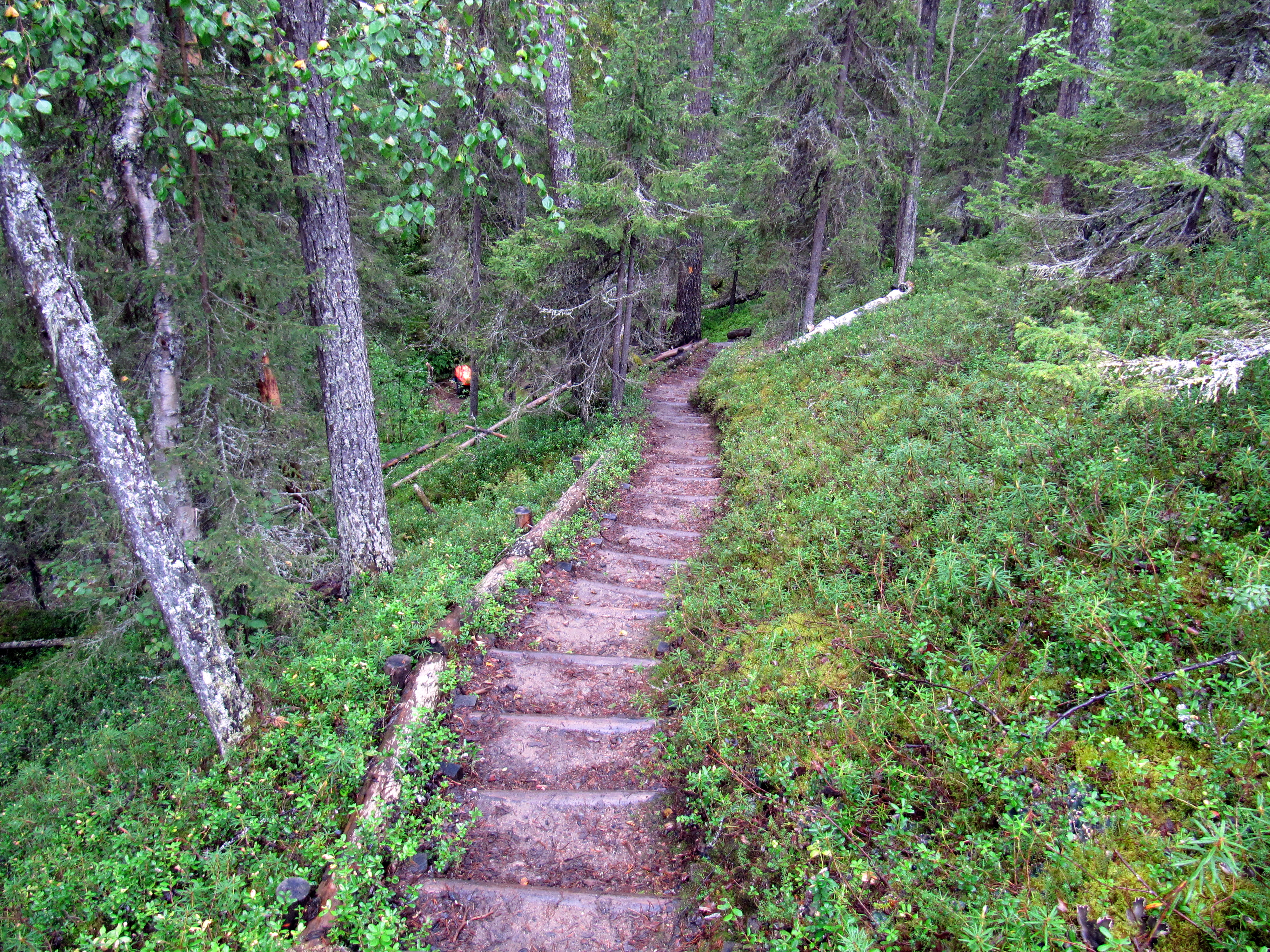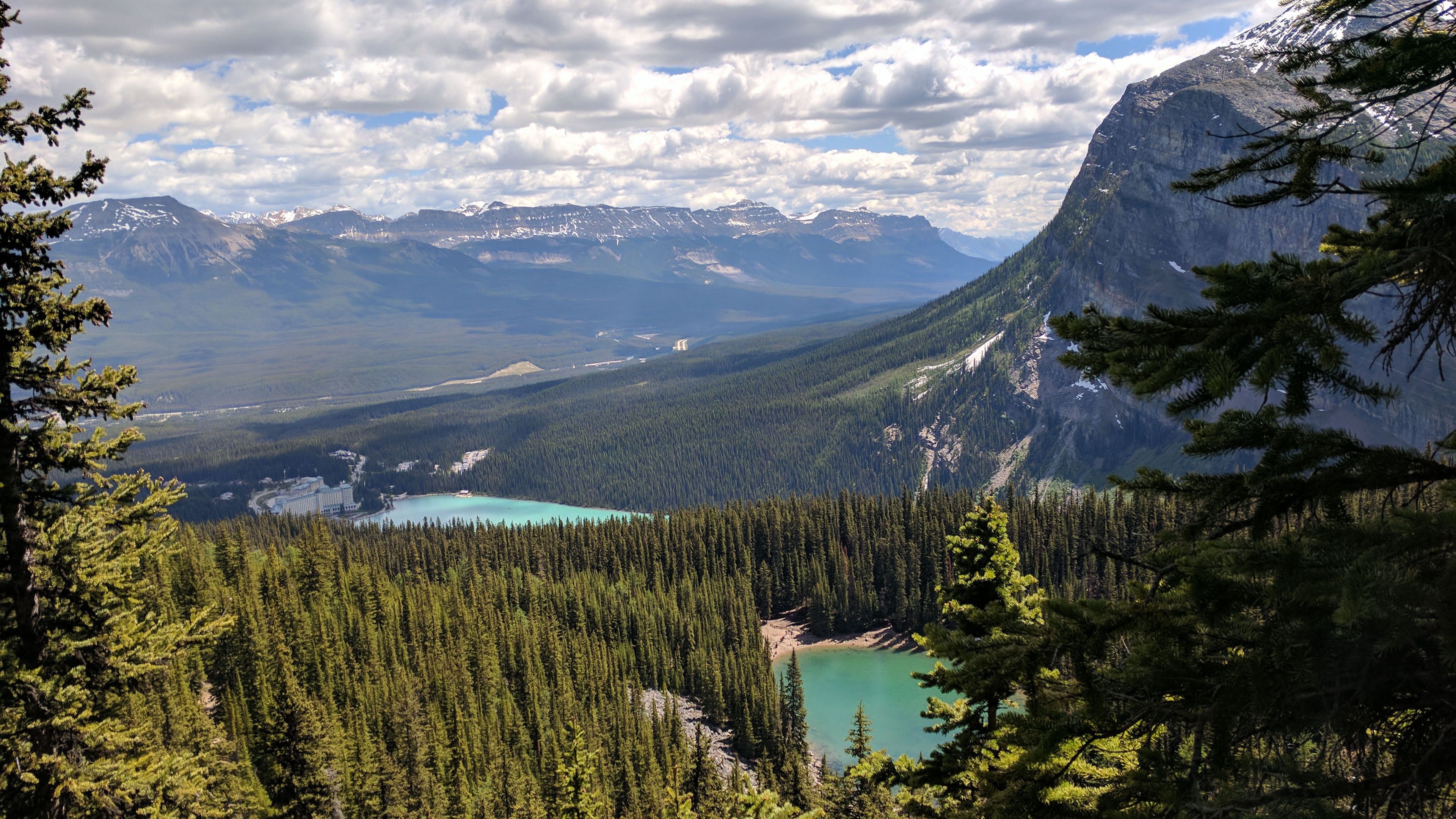|
Scrambling
Scrambling is a mountaineering term for ascending steep terrain using one's hands to assist in holds and balance.''New Oxford American Dictionary''. It can be described as being between hiking and climbing, rock climbing. "A scramble" is a related term, denoting terrain that could be ascended in this way. Sure-footedness and a head for heights are essential. Canyoning and stream climbing both involve scrambling. Overview Scrambling is ascending or traversing a grade without technical apparatus. Unroped ascent in exposure (heights), exposed situations is potentially one of the most dangerous of mountaineering activities. As soon as an ascent involves a rope, going up or down, it is no longer a scramble. Alpine scrambling Alpine scrambling is scrambling in high mountains and may not follow a defined or waymarked path. The Seattle Mountaineers climbing organization defines alpine scrambling as follows: Alpine Scrambles are off-trail trips, often on snow or rock, with a 'non-t ... [...More Info...] [...Related Items...] OR: [Wikipedia] [Google] [Baidu] |
Canyoning
Canyoning (canyoneering in the United States, kloofing in South Africa) is a sport that involves traveling through canyons using a variety of techniques, such as walking, scrambling, climbing, jumping, abseiling (rappelling), swimming, and rafting. Although non-technical descents such as hiking down a canyon ("canyon hiking") are often referred to as "canyoneering", the terms "canyoning" and "canyoneering" are more often associated with technical descents—those that require rappels and ropework, technical climbing or down-climbing, technical jumps, and/or technical swims. Canyoning is frequently done in remote and rugged settings and often requires navigational, route-finding, and other wilderness travel skills. Canyons that are ideal for canyoning are often cut into the bedrock stone, forming narrow gorges with numerous drops, sculpted walls, and sometimes waterfalls. Most canyons are cut into limestone, sandstone, granite, or basalt, though other rock types are found. ... [...More Info...] [...Related Items...] OR: [Wikipedia] [Google] [Baidu] |
Yosemite Decimal System
The Yosemite Decimal System (YDS) is a five-part Grade (climbing), grading system used for rating the difficulty of rock climbing climbing routes, routes in the United States and Canada. It was first devised by members of the Sierra Club in Southern California in the 1950s as a refinement of earlier systems from the 1930s, and quickly spread throughout North America. Description The class 5 portion of the class scale is primarily a rock climbing classification system, while classes 1–4 are used for hiking and scrambling. The current definition for each class is: ; Class 1:Hiking or trail running, running on a trail. ; Class 2:Simple scrambling, with the possibility of occasional use of the hands. ; Class 3: Scrambling. A rope could be carried. ; Class 4: Simple climbing, possibly with exposure (heights), exposure. A rope is often used. Falls could be fatal. Natural protection (climbing), protection can easily be found. ; Class 5: It is considered technical roped free climbing; ... [...More Info...] [...Related Items...] OR: [Wikipedia] [Google] [Baidu] |
Scrambles In The Canadian Rockies
''Scrambles in the Canadian Rockies'' is a climbing guidebook by Alan Kane describing scrambling routes of mountains in the Canadian Rockies. It is published by Rocky Mountain Books, located in Calgary, Alberta Alberta is a Provinces and territories of Canada, province in Canada. It is a part of Western Canada and is one of the three Canadian Prairies, prairie provinces. Alberta is bordered by British Columbia to its west, Saskatchewan to its east, t .... The third edition , released in May 2016, has been updated and contains route descriptions for 175 peaks. The peaks are rated from easy to difficult and information on trail heads and the standard routes are covered. '' Backpacker'' magazine has twice featured the book as an expedition guide. The '' Canadian Alpine Journal'' referred to it as a "scree gospel". The book is solely responsible for creating a widespread interest in scrambling up mountain peaks, whether the peaks are in USA or Western Canada. Since first publishe ... [...More Info...] [...Related Items...] OR: [Wikipedia] [Google] [Baidu] |
Scafell
Scafell ( or ; also spelled Sca Fell, previously Scawfell) is a mountain in the Lake District region of Cumbria, England. It has a height of , making it the second-highest mountain in England after its neighbour, Scafell Pike, from which it is separated by Mickledore col. Topography Scafell stands between Wasdale in the west and upper Eskdale to the east. The highest part of the fell is a ridge running south from Mickledore as far as Slight Side, which is counted as a separate fell by most guidebooks.Richards, Mark: ''Mid-Western Fells'': Collins (2004): Despite regarding Slight Side as a separate entity, Wainwright included the wide upland area beyond it to the south west as a part of Scafell. More modern guides have partitioned the plateau off as a further independent top, Great How. The opposing flanks of Scafell are entirely different in character. To the south, monotonous smooth slopes, stony and lacking vegetation at higher levels, run down toward Burnmoor a ... [...More Info...] [...Related Items...] OR: [Wikipedia] [Google] [Baidu] |
Hiking
A hike is a long, vigorous walk, usually on trails or footpaths in the countryside. Walking for pleasure developed in Europe during the eighteenth century. Long hikes as part of a religious pilgrimage have existed for a much longer time. "Hiking" is the preferred term in Canada and the United States; the term "walking" is used in these regions for shorter, particularly urban walks. In the United Kingdom and Ireland, the word "walking" describes all forms of walking, whether it is a walk in the park or backpacking in the Alps. The word hiking is also often used in the UK, along with rambling, hillwalking, and fell walking (a term mostly used for hillwalking in northern England). The term bushwalking is endemic to Australia, having been adopted by the Sydney Bush Walkers Club in 1927. In New Zealand a long, vigorous walk or hike is called tramping. It is a popular activity with numerous hiking organizations worldwide, and studies suggest that all forms of walking have health b ... [...More Info...] [...Related Items...] OR: [Wikipedia] [Google] [Baidu] |
Helvellyn
Helvellyn (; possible #Names, meaning: ''pale yellow moorland'') is a mountain in the English Lake District, the highest point of the Helvellyn range, a north–south line of mountains to the north of Ambleside, between the lakes of Thirlmere and Ullswater. Helvellyn is the third-highest point both in England and in the Lake District, and access to Helvellyn is easier than to the two higher peaks of Scafell Pike and Scafell. The scenery includes three deep glacial cirque, coves and two sharp-topped ridges on the eastern side (Striding Edge and Swirral Edge). Helvellyn was one of the earliest fells to prove popular with walkers and explorers; beginning especially in the later 18th century. Among the early visitors to Helvellyn were the poets Samuel Taylor Coleridge and William Wordsworth, both of whom lived nearby at one period. Many routes up the mountain are possible so that it may be approached from all directions. However, traversing the mountain is not without dangers; over ... [...More Info...] [...Related Items...] OR: [Wikipedia] [Google] [Baidu] |
Tryfan
Tryfan () is a mountain in the Ogwen Valley, Snowdonia, Wales. It forms part of the Glyderau group, and is one of the most recognisable peaks in Britain, having a classic pointed shape with rugged crags. At above sea level, it is the fifteenth-highest mountain in Wales. Tryfan was voted Britain's favourite mountain by ''Trail'' magazine. Between the mid-1980s and June 2010, its accepted height was . However, it was resurveyed using accurate GPS measurements and found to be 2.4 metres (eight feet) higher (which the pre-1980s surveys also recorded). Tryfan is said to be the final resting-place of Sir Bedivere (Bedwyr) of Arthurian legend. Naming The name "Tryfan" is thought to derive from the intensifying particle ''try–'' and the noun ''ban'' (‘top, peak’), giving the meaning ‘very high peak’. Routes of ascent There are many routes of ascent, ranging from easy ridge scrambling, to multi-pitch mountaineering rock climbs on the east face. A popular ascent route is ... [...More Info...] [...Related Items...] OR: [Wikipedia] [Google] [Baidu] |
Glossary Of Climbing Terms
Glossary of climbing terms relates to rock climbing (including aid climbing, lead climbing, bouldering, and competition climbing), mountaineering, and to ice climbing. ebook: The terms used can vary between different English-speaking countries; many of the phrases described here are particular to the United States and the United Kingdom. A B C D E F G ... [...More Info...] [...Related Items...] OR: [Wikipedia] [Google] [Baidu] |
Climbing Grade
Many climbing routes have grades for the technical difficulty, and in some cases for the risks, of the route. The first ascensionist can suggest a grade but it will be amended for the ''consensus view'' of subsequent ascents. While many countries with a tradition of climbing developed their own grading systems, a small number of grading systems have become internationally dominant for each type of climbing, and which has led to the standardization of grading worldwide. Over the years, grades have consistently risen in all forms of climbing, helped by improvements in climbing technique and equipment. In free climbing (i.e. climbing rock routes with no aid), the most popular grading systems are the French numerical or sport system (e.g. f7c+), the American YDS system (e.g. 5.13a), and latterly the UIAA scale (e.g. IX+). These systems grade technical difficulty being the main focus of the lower-risk activity of sport climbing. The American system adds an R/X suffix to tra ... [...More Info...] [...Related Items...] OR: [Wikipedia] [Google] [Baidu] |
Backpacker (magazine)
''Backpacker'' is an American lifestyle magazine publication that features information on wilderness hiking and adventure. It has been published since 1973. ''Backpacker'' magazine is currently published by ''Outside'' and is based in Boulder, Colorado. Originally started in Bedford Hills, New York, the magazine moved to Emmaus, Pennsylvania in the late 1980s and then to Boulder in August 2007. History The first issue of ''Backpacker'' appeared in the spring of 1973. The first editor's note written by William Kemsley, the founding editor, explains that it took three years to put together the first issue of ''Backpacker,'' and that the founding editors worried that America in the early 1970s did not contain a backpacking community large enough to support a magazine. It also expresses Kemsley's goal to support the magazine primarily through subscriptions rather than advertising. The Winter/Spring 2007 issue of the journal ''Appalachia'' includes an essay by Kemsley titled "How th ... [...More Info...] [...Related Items...] OR: [Wikipedia] [Google] [Baidu] |
Canadian Rockies
The Canadian Rockies () or Canadian Rocky Mountains, comprising both the Alberta Rockies and the British Columbian Rockies, is the Canadian segment of the North American Rocky Mountains. It is the easternmost part of the Canadian Cordillera, which is the northern segment of the North American Cordillera, the expansive system of interconnected mountain ranges between the Interior Plains and the Pacific Coast that runs northwest–southeast from central Alaska to the Isthmus of Tehuantepec in Mexico. Canada officially defines the Rocky Mountains system as the mountain chains east of the Rocky Mountain Trench extending from the Liard River valley in northern British Columbia to the Albuquerque Basin in New Mexico, not including the Mackenzie, Richardson and British Mountains/ Brooks Range in Yukon and Alaska (which are all included as the "Arctic Rockies" in the United States' definition of the Rocky Mountains system). The Canadian Rockies, being the northern segment of ... [...More Info...] [...Related Items...] OR: [Wikipedia] [Google] [Baidu] |







